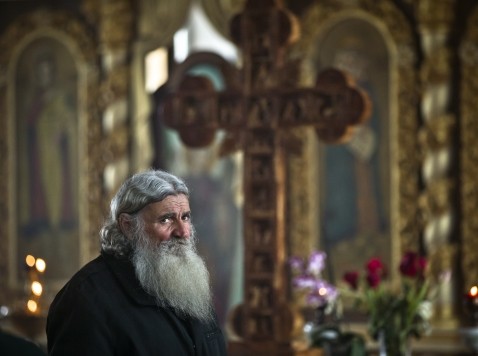
This morning’s key headlines from GenerationalDynamics.com
- Ukraine capitulates to Russia in Crimea
- Russia’s annexation of Crimea splits the Russian Orthodox Church
Ukraine capitulates to Russia in Crimea
Ukraine’s interim government has announced that it will withdraw itstroops from Crimea. It is not known whether Russia plans to invadeeastern Ukraine. BBC
Russia’s annexation of Crimea splits the Russian Orthodox Church
Unlike the Roman Catholic Church, which is united worldwide under asingle Pope in Rome, the Eastern Orthodox Church is actually acommunity of a dozen or so self-governing (“autocephalous”) churchessharing common values. A Catholic is a Catholic anywhere in the world(in theory, anyway), but there’s no such thing as a generic “OrthodoxChristian.” You have to be Orthodox PLUS something else — RussianOrthodox or Greek Orthodox, for example. A Greek Orthodox wouldreject becoming a Catholic, but just as important, he would neverbecome a Russian Orthodox either.
There is an amusing anecdote describing how the Russian OrthodoxChurch was founded in Kiev. The anecdote involves a pagan princenamed Vladimir, who in 980 became ruling prince of the Slavs,headquartered in Kiev. And Prince Vladimir went religion shopping.
According to legend, he rejected Islam, because it forbade alcoholicdrink. He sent commissions to visit the Christian Churches. TheBulgarians, they reported, smelt. The Germans had nothing to offer.But Constantinople (or Byzantium) had won their hearts. There, theysaid in words often to be quoted, “We knew not whether we were inheaven or earth, for on earth there is no such vision nor beauty, andwe do not know how to describe it; we know only that there God dwellsamong men.” Around 986-8, Prince Vladimir was baptized as an OrthodoxChristian by a Byzantine emperor in the Greek colony of Chersonesos –near Sevastopol in Crimea. Vladimir accepted Orthodox Christianityfor himself and his people. Vladimir might have chosen Catholicism,and thus would one man have changed the history and the map of theworld. In the centuries to come, the Slav culture moved east andformed the Russian Empire.
Well, Kiev was conquered by the Mongols in 1240, while Constantinoplewas conquered by the Ottoman Muslims in 1453, and became Istanbul.
With the destruction of Rome by the Visigoths, and the destruction ofConstantinople by the Ottomans, by 1472 Ivan the Great decided thatMoscow was going to become “the third Rome,” the home of the true (orhimself the title “Czar” or “Tsar,” derived from the name of the RomanEmperor Caesar (as is the German word “Kaiser”).
Thus, the Russian Orthodox Church became married to the Russian state.This led Russia to enter the Crimean war as a generational crisis warin the 1850s in its role as the defender of Jerusalem. The Crimeanwar was a disaster for Russia and led in the following generationalAwakening era to Russia’s “Nihilist Movement,” which rejected both theChurch and the State, and can be thought of as an extremely violentanalog to the violent protests in America in the 1960s. The NihilistMovement grew and became the lynchpin of the next generational crisiswar, the Bolshevik Revolution in 1917. The Tsarist state wasdestroyed, and the Russian Orthodox Church was destroyed, though itwas revived in the Soviet era during World War II when it was neededto help fight the Great Patriotic War against the Nazis. Since theSoviet Empire collapsed in the 1990s, the Russian Orthodox Church hasonce again become close to the Russian state.
Like a dog wagging its tail, changes in the Russian Orthodox Churchhave pushed the Ukrainian Orthodox Church through multiple chaoticevents throughout this millennium of history. Sometimes it wassubordinate to the Moscow Church, sometimes it was completelyself-governing. When the Soviet Union collapsed in the 1990s, theUkrainian church itself was split, with the result that there werethree Orthodox jurisdictions in Ukraine:
- The biggest one is the Ukrainian Orthodox Church, still subordinate to the Moscow Church, with 10,865 parishes and 9,072 clergy.
- Next is the Ukrainian Orthodox Church – Kiev Patriarchate, which has 3,721 parishes served by 2,816 clergy.
- The Ukrainian Autocephalous Orthodox Church is the smallest, with 1,166 parishes and 686 clergy, mostly concentrated in western Ukraine.
At one time, it was hoped that these three churches would eventuallymerge, possibly even become entirely subordinate to the Moscowchurch. But Russia’s annexation of Crimea has thrown any suchhope into chaos, and it poses a serious threat to the Moscowchurch.
The Bishops of Crimea are requesting that their Orthodox churchesbecome subordinate to the Moscow church, rather than be a part of anyof the Ukrainian churches. The Moscow church faces two bad choices:
- If the Moscow Patriarchate takes control of the Orthodox churches in Crimea, then many of the 10,865 parishes in the Ukrainian Orthodox Church (currently subordinate to Moscow) would demand to pull away from Moscow and become part of the Kiev Patriarchate. The Moscow Patriarchate would then not only lose a lot of prestige and power, it would also lose a great deal of income.
- But if Moscow Patriarchate does not demand complete control over the Crimean churches, then many Russians and especially Russian nationalists are likely to view that as an act of betrayal by the Church, giving the appearance of hypocrisy and loss of faith at home.
It’s worth pointing out that the Kiev Patriarchate is stronglyopposing the actions of the Russian state in annexing Crimea, whilethe Moscow Patriarchate is supporting those actions. One possibleoutcome is an ironic one: that the Crimean churches join Moscow, andthe three Ukrainian churches finally unite into a single autocephalouschurch as the Kiev Patriarchate. So the Russian action in Crimea mayfinally unite the Kiev Patriarchate, but not in the way that theMoscow Patriarchate had hoped.
Russia’s annexation of Crimea has changed the map of Europe by force,for the first time since WW II, and may have changed the map of theOrthodox world as well. Religion News and Washington Post and Catholic Culture and Jamestown
Permanent web link to this article
Receive daily World View columns by e-mail

COMMENTS
Please let us know if you're having issues with commenting.